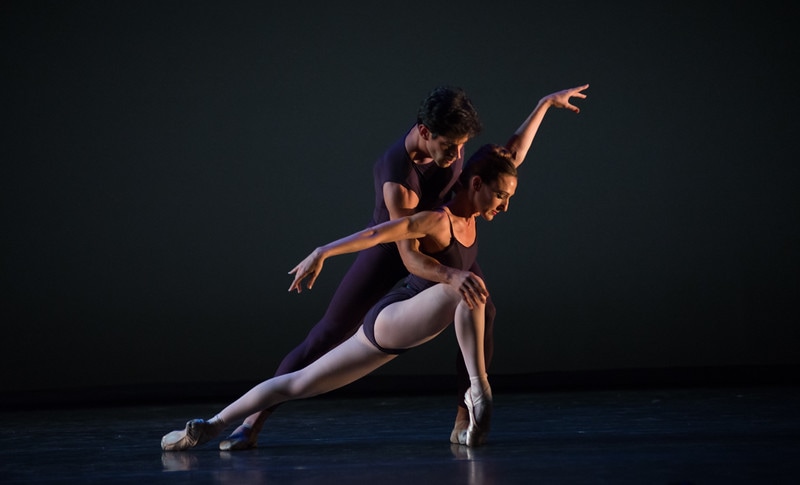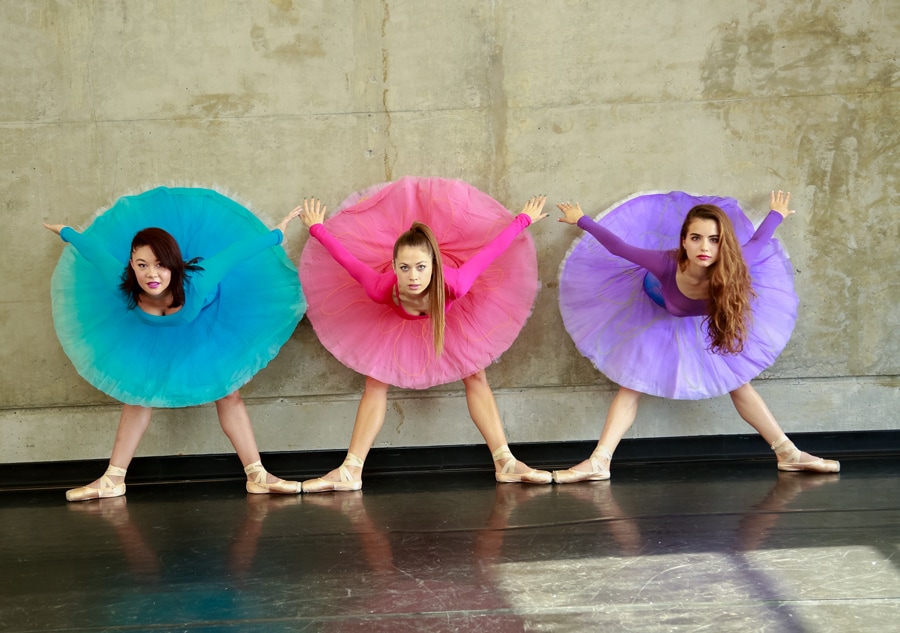|
Stella Abrera as Tatiana with David Hallberg as Onegin. On America’s shores, choreographer John Cranko is rarely given his due. Thank heavens for American Ballet Theatre, which delves in the treasures that lay beyond New York with a rich mix of the world’s greatest dance makers – including Cranko.
The South African born choreographer made his name in London and Stuttgart. But his ballets languished after his early death at age 45. Yet Cranko’s brilliance for drama was revived in the heart-shattering ABT staging of his “Onegin.” The tragic love story based on the Pushkin’s verse novel and the opera with music by Tchaikovsky is beautifully staged and well told. While the well-appointed sets and costumes by Santo Loquasto continually capture the eye – it’s the rapid advancing story telling that keep audience’s interested. Cranko does not dawdle by overloading the with ballet frivolous ensemble sections. He sets the scene with the corps de ballet and then cut to the chase -- the calamitous love between the troubled and callous Onegin and the sweet Tatiana. It’s no wonder Diana Vishneva chose the lead in “Onegin” for her farewell performance on Friday night. While I unfortunately missed that, I was thrilled to see Saturday’s matinee at the Metropolitian Opera House with Stella Abrera as Tatiana and Cory Stearns as Onegin. It was deeply satisfying. Abrera was ideal as the bookish country girl who falls for the stately and arrogant Onegin. She infused her portrayal with a light, but earnest touch, clearly conveying her hopeful affections and her devastation when Onegin rebuffs her advances. Stearns was a match for her with a delivery that left all convinced that Onegin was completely soulless as he so easily shatters Tatiana and then shoots his friend Lensky in a duel the very same night. Of course, much of their ability to nail character is inherent in Cranko’s unfettered choreography that bores into the bone of their feelings. As Tatiana throws herself at Onegin and then in the end Onegin throws himself at her, there is no doubt about the depth of their emotions. Joseph Gorak, as Onegin’s unlucky friend Lensky, was also terrific. His technique is flawless. And as Lensky, he too took the audience on his own emotional ride – with his soaring joy in his love for Olga and his fateful anger at Onegin for dancing with her at a Tatiana’s birthday party. It was also wonderful to see Martine van Hamel on stage once again as Madame Larina. While she no longer whips off fouettes, her knowledge of all things ballet shines through in her presence. Of course, there is not better partner for ballet than the music of Tchaikovsky. Conductor Charles Barker led the orchestra through this grim tale with force and passion. All in all, ABT demonstrated why it is one of the best ballet companies in American.
1 Comment
Tricia Albertson and Reyneris Reyes were incredible in Christopher Wheeldon's "Polyphonia" pas de duex. Imagine New York City Ballet as a chamber company – a small band of fiercely talented dancers who can whip off anything in the big ensemble’s repertoire.
Then you are imagining Miami City Ballet. The company is proving its mettle this week at Jacob’s Pillow as the 85th season’s opener. And it’s a delight display of staple choreography by George Balanchine, Peter Martins and Christopher Wheeldon. This expertise should come as no surprise as the company was founded by City Ballet superstar Edward Villella. Yet the Miami crew has been elevated to another level with the leadership of Lourdes Lopez, yet another former City Ballet principal known for not only for her steely technique, but her dazzle. She has clearly transferred this same passion to her Miami dancers. The evening opened with Balanchine’s “Allegro Brilliante,” which is set to Tchaikovsky’s Third Piano Concerto, Op. 75 – Unfinished. As the curtain was raised, the dancers were already swirling in its peach and blue Karinska-designed costumes. Two things caught the eye immediately – the dancers’ unity, they moved as one, and their footwork. The petit allegro was swift, precise and refreshing. The ballet, led by Jennifer Lauren and Renan Cerdeiro, hypnotizes with its whirlwind of geometric patterns that form, dissolve and reshape in starbursts, lines and circles. Together, the fine dancing and the design make for a foolproof winner. The unity in dancing was also emphasized in Wheeldon’s shadowy “Polyphonia,” to the strange piano piece by Gyorgy Ligeti, played live by Francisco Renno. Designed for four couples, the ballet takes the viewers through the contortions of music with sharp shapes and syncopated moves that gather the audience’s intense interest. Of course, one can’t help but be nostalgic for Wendy Whelan and Jock Soto, the original dancers in the 2001 work. But Tricia Albertson and Reyneris Reyes were perfect in the roles. The tone and eeriness of the pas de deux was preserved; and in the small Ted Shawn Theatre, heightened. Sandwiched between these two marvelous ballets was Martins’ “Barber Violin Concerto.” I must admit, it’s not one of my favorites. It features a classical couple juxtaposed to a contemporary one who then switch off with varying degrees of success. What made last night’s airing of the ballet a treat was the dancing of Nathalia Arja who relished her role as the spritely modern female who does her best to awaken the staid and dreamy Rainer Krenstetter. One of the reasons I don’t like this ballet as their section together feels too violent, especially when he chops off her head with a swipe of his arm – twice. But Arja more than held her own, unharmed by the cavalier’s obvious annoyance of her spirit and stamina. That was clear in the smile that she couldn’t hold back through the entire dance and the curtain call. She and Miami City Ballet are a joy that should be experienced. Ballet Next When first introduced to Ballet Next at Kaatsbaan International Dance Center, the company was a stable of top dancers. Founded by former American Ballet Theatre principal Michele Wiles, it included New York City Ballet’s Charles Askegard, Georgina Pazcoguin and Kaitlin Gilliland.
But now, five years later, it’s appears to be a student company, a band of uncertain and under rehearsed young women who are still wobbly in their pointe shoes. And they are dancing works by Wiles that range from beautiful to undeveloped to downright strange. Wiles’ husband James McCullough explained that Saturday’s night show at Kaatsbaan was in preparation of an upcoming tour. One can only hope that it is well in advance of the tour as much work is needs to be done on all aspects before Ballet Next is ready for a larger stage. It wasn’t a total failure, however. First off, Mauro Bigonzetti’s “La Folia” is a joy. Its accompanying Vivaldi was played live by Elliot Figg on piano and Holly Nelson on violin. Both dove into the music, as they did all night, was exhilarating drive. The dancing was lopsided, however. The zesty duet, with Erin Chong and Lillian DiPiazza, toyed with mirroring and foiling, with speed. But the technical distinction between DiPiazza, a member of Pennsylvania Ballet, and Chong, a former Washington Ballet dancer, was rattling. DiPiazza stretched the movement, sending it energy up and beyond the audience. Chong, while lovely, looked woefully inadequate next to her. But DiPiazza seemed unsure of the choreography, watching Chong as she went along. DiPiazza was always a split second behind. Still, this was the best piece of choreography on the program. Wiles’ “Experience Pas de Deux,” while not as interesting movement-wise, but it was pleasing. It coupled two dancers who were better suited to each other – Violetta Komyshan and Natalie Stys – as they were on par with each other’s abilities. The dance was colored with a lot of hand gestures, spiraling around faces and bodies. While there were no bold strokes, it was pleasant. The odd part of the evening was the inclusion of flex dancer Jay Donn. This street dance-style that hails from Brooklyn is fascinating to watch – but jarring tossed into a ballet. In “La Stravaganza” and “The Game,” Wiles was clearly experimenting with the flashy Donn, but it just didn’t work. This is not to take away from Donn who surprises with his pointe work in sneakers and his ability to bend and leap over a quartet of dancers. But the way Wiles brought him in didn’t really make any sense. It was a bizarre and poorly executed attempt to give Ballet Next an innovative edge. One more thing, every dance looked to have the same costumes – just modified slightly – which looked amateurish. For Ballet Next to take it to the next level, it needs better costumes, choreography and dancers. But keep those musicians. After nearly 30 years as a dance critic, I thought stepping away from opening nights and teary curtain calls would be good for me. I’d finally have more free time. Maybe I could pen a novel, spend more time with family and friends or simply enjoy quiets evenings at home. But after witnessing Rudolf Nureyev fly across the Metropolitan Opera stage 45-years-ago, I have believed that dance was my life’s calling – that I existed to trumpet its virtues, elevate its dedicated artists and along the way, slap down a few that sully it’s ephemeral glory. So here I am – back at humbly attempting to do the impossible – put stodgy words to what can only be expressed through the silent voice emanating from bone, muscle, sinew and flesh. In this blog, I will share with any kind reader who finds their way to me, my impressions of ballet, modern and contemporary dance that orbits the upstate New York region and beyond. Join me. -Wendy Liberatore |
Wendy
|



 RSS Feed
RSS Feed
